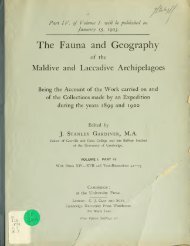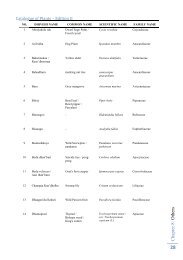684 L. A. BORRADAILE.arrangement is found in the other subgenera of Lambrus^. In this case, however, thereare two shallow grooves, an outer one running outward and an inner one running forwardfrom the gill-opening, and both uncovered (PI. XLVII. fig. 5 b). The rough, knobbed backof the Parthenopinae is like that of Calappn, but a similar texture is so <strong>com</strong>mon amongcrabs that little can be argued from it. Probably it is less conspicuous on a sandy bottomwith coral pebbles than a quite smooth object would be.We have already stated that the Oxyrhyncha are among the sluggish groups of crabs.When they are seized they do not attempt to defend themselves with their chelae, butmove their legs feebly and aimlessly. Indeed the Parthenopinae—like the Calappidae inthis respect also—often seem to be hypnotised by being moved, drawing up their legs underthem and remaining still. In general the intelligence of the group is of a low order, withthe single exception of their cleverness in disguise, which, after all, is probably no morethan a fairlysimple reflex.Fig. 1'22. Elamena gracilis; a. whole auimal, h. outside of hand.Of the 29 species in the collection made by the expedition, three are new. The restare all recorded from the Indian region by Major Alcock^ with the exception of two whichwere described as new by Miss Rathbun in her account of Prof. Agassiz's Maldive Crabs ^The following systematic list sets forth these species in order.Family Hymenosomidae.Genus Elamena H. M.-Edw., 1837.1. Elamena gracilis, n. sp. (Fig. 122)Diagnosis :" An Elamena in which the sides of the hinder part of the body are straightfrom the 4th to the 1st pair of legs, and then turn inwards almost at right angles to' Owing to lack of material I am unable to say whether Journ. As. Soc. Bengal.this groove is found throughout Parthenopinae. ^ Bull. ilus. Harvard, xxxix. 5 (1902).- In his series of papers on the Indian Ciabs in the
in;MARINE CRUSTACEANS. 685join the fore part, which is triangular, with very slightly irregular sides; the front alsotriangular but with indications of two teeth at its sides; the eyes showing a small partof the cornea at the sides of the front when seen from above ; the chelipeds short, slender,with narrow, sjDooned fingers about as long as the palms ; and the walking-legs slender,with a spine at the end of the merojDodite, and the last joint strongly hooked, with agroup of little thorns underneath at the tij) and a fringe of hair all along."Length of longest specimen : 6 mm. Breadth : 7 mm. Colour : spirit, pale yellowwhen alive, legs black-brown, rest of body transparent.A female was taken at Minikoi, and a male and female at Hulule, Male Atoll, all onthe reefFamily Maiidae.Subfamily Inachinae. Genus Achaeus Leach, 1815.2. lAchaeus spinosus Miers, 1879. Alcock, i. p. 171'.My specimen agrees with Alcock's and Miers' descriptions, but the last two pairs oflegs have strongly curved end-joints. Miers and Alcock only mention the last pair.Dredged in Mahlos Atoll in 24 fathoms.Fig. 123. Ocinopus aranea ; a. whole animal, b. two of the hairs on the hinder pair of legs, c. one of the long hairson the legs of the second and third pairs, d. hooked hairs.Genus Ocinopus de Haan, 1837.3. Ocinopus aranea de Haan, 1837. Alcock, i. p. 183 (Fig. 123).The shape of the lobes at the tip of the rostrum in this species varies somewhat.A very <strong>com</strong>mon crab, taken practically throughout the group in 19—45 fathoms.' For a statement of the principles on which references Alcock's paper on the Indian Oxyrhyncha appeared in Journ.are given in this series of papers see above, p. 192. Major As. Soc. Bengal, lxiv. ii. 2, p. 157 (1895).G. II. 88
- Page 7 and 8:
The Fauna and Geographyof theMaldiv
- Page 9 and 10:
The Fauna and Geographyof theMaldiv
- Page 11:
CONTENTS OF VOL. II.PAKT II.Reports
- Page 14 and 15:
..590 EDGAR A. SMITH.60at3aso-73a
- Page 16 and 17:
—592 EDGAR A. SMITH.3 SC3dSaitnhe
- Page 18 and 19:
,594 EDGAR A. SMITH.3-a ao5j,Moss3
- Page 20 and 21:
.596 EDGAR A. SMITH.3oa o"?!00 >iId
- Page 22 and 23:
598 EDGAR A. SMITH.3isaa'a
- Page 24 and 25:
600 EDGAR A. SMITH.Family ACTAEONID
- Page 26 and 27:
602 EDGAR A. SMITH.23. Conus lividu
- Page 28 and 29:
604 EDGAR A. SMITH,59. Harpa ventri
- Page 30 and 31:
606 EDGAR A. SMITH.Family BUCCINIDA
- Page 32 and 33:
608 EDGAE A. SMITH.below the suture
- Page 34 and 35:
610 EDGAB, A. SMITH.135. Sistrum bi
- Page 36 and 37:
612 EDGAR A. SMITH.173. Cypraea cla
- Page 38 and 39:
614 EDGAR A. SMITH.211. Triforis gr
- Page 40 and 41:
616 EDUAK. A. SMITH.which is a para
- Page 42 and 43:
. 270.618 EDGAE A. SMITH.265. Clanc
- Page 44 and 45:
620 EDGAR A. SMITH.the shell being
- Page 46 and 47:
622 EDGAE A. SMITH.slender riblets
- Page 48 and 49:
624 EDGAR A. SMITH.330. Area (Barba
- Page 50 and 51:
626 EDGAR A. SMITH.FamilyPETRICOLID
- Page 52 and 53:
628 EDGAR A. SMITH.9. Chemnitz. Con
- Page 54 and 55:
630 EDGAR A. SMITH.Fig. 22. Natica
- Page 57:
Plate XXXVI.mii>>-*"^-^ii,.•^16./
- Page 60 and 61:
632 B. C. PUNNETT.Willeyia hisulcat
- Page 62 and 63:
634 R. C. PUNNETT.No. of Specimen.(
- Page 64 and 65:
636 R. C. PUNNETT.Internal structub
- Page 66 and 67:
638 R. C. PUNNETT.The nuchal skelet
- Page 68 and 69:
640 R. C. PUNNETT.deeply sunk posit
- Page 70 and 71:
642 E. C. PUNNETT,but no giant cell
- Page 72 and 73:
644 R. C. PUNNETT.Ptychodera flava,
- Page 74 and 75:
646 R. C. PUNNETT.(PI. XLVI. fig. 4
- Page 76 and 77:
648 R. C. PUNXETT.The racemose orga
- Page 78 and 79:
650 E. C. PUXXETT.vialdivensis proc
- Page 80 and 81:
652 R. C. PUNNETT.Collar. The muscu
- Page 82 and 83: 654 R. C. PUNNETT.Table 5.Pt. flava
- Page 84 and 85: 656 R. C. PUNNETT.whilst the oesoph
- Page 86 and 87: 658 R. C. PUNNETT.is always complet
- Page 88 and 89: 660 R. C. PUNNETT.Lastly there is a
- Page 90 and 91: 662 R. C. PUNNETT.apparently devoid
- Page 92 and 93: 664 R. C. PUNXETT.— '^^S*-!^^- Me
- Page 94 and 95: 666 R. C. PUNNETT.-Scr.— tu« HJ=
- Page 96 and 97: 668 E. C. PUNNETT.I ha\-e therefore
- Page 98 and 99: 670 K. C. PUNNETT.gonad spells incr
- Page 100 and 101: 672 R. C. PUNNETT.Table 11(continue
- Page 102 and 103: 674 R. C. PUNNETT.Table 13.Pt. flav
- Page 104 and 105: 676 R. C. PUNNETT.nlc.
- Page 106 and 107: 678 R. C. PUNNETT.Pig. 37. Ft. flav
- Page 108 and 109: 680 R. C. PUNNETT.PLATE XLV.Fig. 42
- Page 111: Fa-UTia and Geography Maldives and
- Page 115: 'Fauna and Geography Maldives aiid
- Page 119: Fauna and Geography, Maldives and L
- Page 123: Fauna and Geography, Maldives and L
- Page 127: Fauna and Geography, Maldives and L
- Page 130 and 131: (582 L. A. BORRADAILE.typical membe
- Page 134 and 135: :686 L. A. BORRADAILE.Subfamily Aca
- Page 136 and 137: 688 L- A. BORRADAILE.gaping. The sp
- Page 138 and 139: :690 L. A. BORRADAILE.26. Lambrus (
- Page 140 and 141: 692 L. A. BORRADAILE.(12) The third
- Page 142 and 143: 694 L. A. BORRADAILE.macrurous grou
- Page 144 and 145: :696 L. A. BORRADAILE.the whole, ho
- Page 146 and 147: 698 L. A. BORRADAILE.2. 6th alxloni
- Page 149: Fauna and Geography, Maldives and L
- Page 156 and 157: 7. Lepidoptera ... .;...... 123Volu
- Page 158: It was supposed that the whole work






